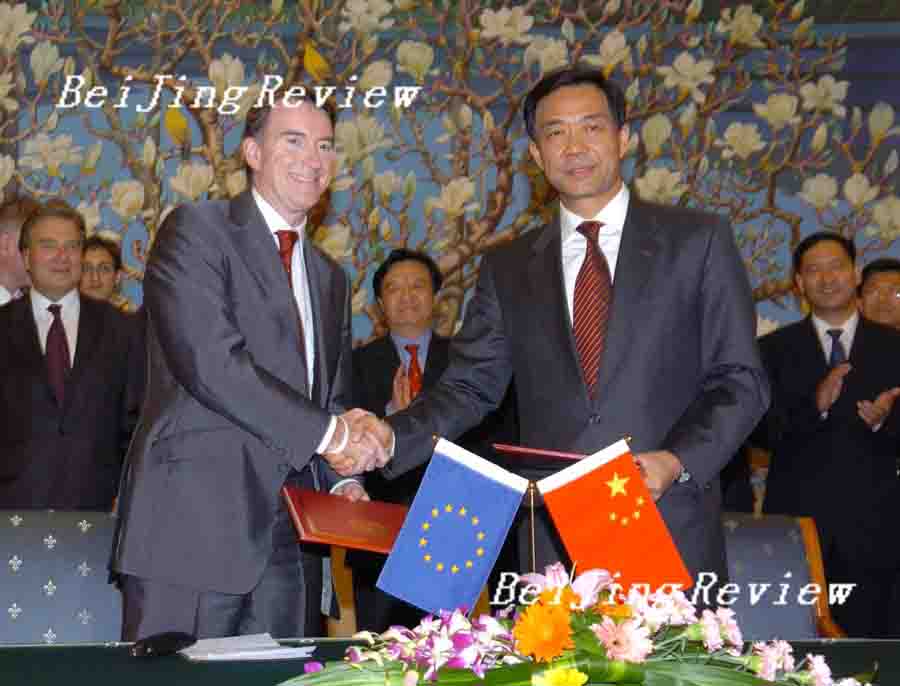
Among all the advanced countries and regions, the European Union (EU) is China's most stable and mature trading partner. Since China established diplomatic ties with the European Economic Community in 1975, especially after the EU published its first policy paper on China in 1995, Sino-EU relations have developed rapidly, from an all-round partnership to an all-round strategic one. In addition to working together on bilateral issues, the two sides also cooperate on global ones such as climate change, United Nations reform and WTO negotiations, as well as global scientific and technological cooperative projects such as the International Thermonuclear Experimental Reactor.
Economic and trade interests are the basic elements of ties between China and the EU. In 2004, the bilateral trade volume reached $177.3 billion, which was 15.4 percent of China’s total foreign trade volume that year, and 74 times the amount of their trade in 1975. In 2005, the trade volume increased 22.6 percent, reaching $217.3 billion. During the first four months of 2006, Sino-EU trade volume was as high as $78.6 billion, rising 20.5 percent over the same period last year.
To China, the EU is the biggest trade partner and technology exporter. To the EU, China is its second biggest trade partner.
In fact, the EU is among the most important foreign investors in the world. According to the Organization for Economic Coopera-tion and Development (OECD), from 1995 to 2004, six of the EU’s member states, Britain, France, the Netherlands, Spain, Germany and Italy, were on the world’s top 10 investors list.
As of October 2005, there were 22,076 EU companies in China, with contractual investments valued at $84.7 billion, and actual input valued at $46.7 billion. In 2005, EU countries invested in 2,846 projects in China, with a total contractual value of more than $11.53 billion, and actual investment of more than $5.19 billion.
EU investment in China mainly is concentrated in fields involving significant technological elements. Most of these projects are of good quality and benefit, for example, the maglev train, Airbus plane and nuclear power station.
The trade is benefiting both sides. Thanks to inexpensive consumables from China, the EU eased its inflation pressure, which has been becoming bigger since the 1990s. When China attempted to raise the salaries of its workers, which could lead to increases in the cost of Chinese products, EU countries began worrying that inflation pressure might flare up.
In the long term, the EU will continue to remove parts of its industries to foreign countries by continuing investment, and China will be its top choice, for the following reasons:
First, in Europe, and especially in the EU member countries, the issue of an aging population is becoming increasingly serious. It is estimated that in the next 10 to 15 years, the proportion of working population to retired population will change to 1:1.5 from the current 1.5:1, which will endanger the whole social insurance system. Not counting immigrants, the proportion will be even more shocking. However, by encouraging immigration, the EU will be at risk of changing the forms of nations and cultural characteristics. To solve this problem, the EU needs to invest overseas, so as to share the results of economic developments with other regions in the world, especially East Asia, which currently enjoys the fastest development.
Second, the labor cost in European countries is extremely high, thus EU countries need to transfer some of their less-competitive sectors, especially those requiring a lot of labor, to overseas countries.
Third, East Asia, China especially, is experiencing rapid market growth. Companies in the EU must get closer to their consumers. The best choice for EU investors is a country with a huge population and increasing national income.
Sino-EU trade not only benefits China and European countries now, but also will benefit them more in the future. However, this is not to say that trade relations will go smoothly and without any obstacles. In fact, the truth is to the contrary.
Since the 1970s, European countries have launched anti-dumping stipulations on Chinese products. Last year’s textile dispute, the current anti-dumping case involving shoes and the disagreement on auto parts have been attracting attention from Chinese society.
|
.jpg)
.jpg)